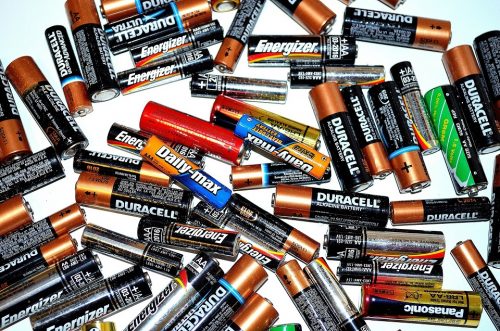Batteries have revolutionized modern life. Now, there is a push for batteries to undergo their own revolution. The electronics we use on a daily basis run on lithium-ion batteries, but a new battery with lower cost and higher energy density has emerged: lithium-sulfur batteries (LSBs). Though attractive for these features, LSBs carry a risk of high-energy explosions, and the energy capacity of LSBs fades much more quickly as charging cycles are completed. Professor Hailiang Wang’s team at Yale’s Energy Sciences Institute has discovered that making LSBs with specific materials can minimize the battery’s rapid fading time and safety risk.
Different stages of a reaction between lithium and sulfur ions allow the battery to store and deliver energy. When the battery is fully charged, lithium and sulfur are separated. As electrons move from the negatively charged anode to the positively charged cathode, supplying energy to the circuit, lithium ions move and bond to sulfur ions on the cathode. Through a multi-step reaction, the sulfur becomes lithium sulfide. The intermediaries of this chemical reaction are referred to as lithium polysulfides (LPS). The LPS molecules are soluble and free to move about in the electrolyte solution connecting the cathode and the anode.
Currently, the cathode loses hold of these intermediaries over the course of many charging cycles. These lost molecules no longer contribute to the battery’s charge storage, and this loss makes the energy capacity fade. The free movement of LPS can also be dangerous. “They could react with the other side of the battery
[the anode]
and cause safety problems,” Wang said. To make the batteries safer and to prevent the fading of energy capacity, LPS molecules must be held in place.
Scientists building LSBs used empirical evidence to determine which materials accomplished this goal best. However, the conceptual understanding of why one surface was better than the next remained hidden. What Wang’s team determined, however, is that the relationship between material and ability to capture LPS molecules depends on the oxidation state of the surface. When oxygen binds to the surface of a material, it changes the structure of the outer atoms by reorienting them in a manner that creates a “rougher” polar surface. The polarity of the surface would be able to bind the polar LPS. The team experimentally proved that if a surface has a rough oxidation layer, it is able to create the bonds that can constrain LPS. To provide further evidence for this explanation, the team also demonstrated that LPS will not bind to a smooth surface that has no oxidation layer.
In the experiment, Professor Wang’s team tested three sample surfaces. One, the control, was simply made of carbon nanotubes. The second had cobalt-phosphorus (CoP) nanoparticles attached to its carbon nanotube surface, which was allowed to naturally oxidize. The third also had CoP over the carbon nanotubes, but this sample was reduced to have no oxidized surface. All three samples were soaked in an LPS solution, and after twenty-four hours, the samples underwent two tests. The first was to qualitatively observe whether the original solution, laden with colored LPS, had become clear. If LPS had bonded to the surface, the solution would become colorless. Then, the binding energy between the surface material’s electrons and nucleus was quantified via X-ray photoelectron spectroscopy. A change in this energy would indicate that new bonds had formed between LPS and the surface matieral.
Professor Wang’s team found that essentially no LPS molecules bonded to either the reduced or control surface. The color of the LPS solution remained unchanged and the spectroscopy showed no change in the binding energy of the surface’s electrons. The reduced and control surfaces were so smooth that there were no areas for the LPS to bond to. In contrast, LPS did bond to the oxidized surface. The solution was colorless and there were significant changes in the electron’s binding energy. This confirmed chemical bonds had formed.
“In LPS molecules, the lithium is positively charged and the sulfur is negatively charged. Oxygen on the surface is attracted to these charges, and this makes the cobalt surface more positively charged. The oxygen activates the cobalt so that the cobalt can be attracted to the sulfur,” Wang explained. Thus, only the CoP surface with an oxidized layer has the charge formation necessary to attract LPS. Professor Wang’s discovery provides a conceptual understanding of why these surfaces are effective. In order to make lithium sulfur batteries safer and longer lasting, Wang concludes that they must be made with surfaces that have the rough, oxygen-activated structure necessary to bind LPS molecules in place.

